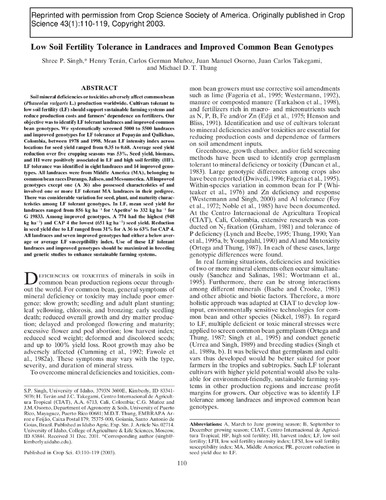Low soil fertility tolerance in landraces and improved common beans genotypes
Abstract
Soil mineral deficiencies or toxicities adversely affect common bean (Phaseolus vulgaris L.) production worldwide. Cultivars tolerant to low soil fertility (LF) should support sustainable farming systems and reduce production costs and farmers' dependence on fertilizers. Our objective was to identify LF tolerant landraces and improved common bean genotypes. We systematically screened 5000 to 5500 landraces and improved genotypes for LF tolerance at Popayán and Quilichao, Colombia, between 1978 and 1998. Mean LF intensity index across locations for seed yield ranged from 0.35 to 0.68. Average seed yield reduction over five cropping seasons was 53%. Seed yield, biomass, and HI were positively associated in LF and high soil fertility (HF). LF tolerance was identified in eight landraces and 14 improved genotypes. All landraces were from Middle America (MA), belonging to common bean races Durango, Jalisco, and Mesoamerica. All improved genotypes except one (A 36) also possessed characteristics of and involved one or more LF tolerant MA landraces in their pedigree. There was considerable variation for seed, plant, and maturity characteristics among LF tolerant genotypes. In LF, mean seed yield for landraces ranged from 856 kg ha?1 for ‘Apetito’ to 332 kg ha?1 for G 19833. Among improved genotypes, A 774 had the highest (948 kg ha?1) and CAP 4 the lowest (651 kg ha?1) seed yield. Reduction in seed yield due to LF ranged from 31% for A 36 to 63% for CAP 4. All landraces and seven improved genotypes had either a below average or average LF susceptibility index. Use of these LF tolerant landraces and improved genotypes should be maximized in breeding and genetic studies to enhance sustainable farming systems.

